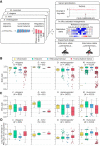Modeling transcriptional regulation of model species with deep learning
- PMID: 33888512
- PMCID: PMC8168591
- DOI: 10.1101/gr.266171.120
Modeling transcriptional regulation of model species with deep learning
Abstract
To enable large-scale analyses of transcription regulation in model species, we developed DeepArk, a set of deep learning models of the cis-regulatory activities for four widely studied species: Caenorhabditis elegans, Danio rerio, Drosophila melanogaster, and Mus musculus DeepArk accurately predicts the presence of thousands of different context-specific regulatory features, including chromatin states, histone marks, and transcription factors. In vivo studies show that DeepArk can predict the regulatory impact of any genomic variant (including rare or not previously observed) and enables the regulatory annotation of understudied model species.
© 2021 Cofer et al.; Published by Cold Spring Harbor Laboratory Press.
Figures



Similar articles
-
Developmental Constraints on Genome Evolution in Four Bilaterian Model Species.Genome Biol Evol. 2018 Sep 1;10(9):2266-2277. doi: 10.1093/gbe/evy177. Genome Biol Evol. 2018. PMID: 30137380 Free PMC article.
-
Early developmental expression of Mus musculus zinc finger RNA-binding protein compared to orthologs in Caenorhabditis elegans and Danio rerio and subcellular localization of Mus musculus and Caenorhabditis elegans zinc finger RNA-binding protein in 2-cell Mus musculus embryos.DNA Cell Biol. 2010 Dec;29(12):713-27. doi: 10.1089/dna.2010.1085. Epub 2010 Nov 22. DNA Cell Biol. 2010. PMID: 21091219
-
Similarities of developmental gene expression changes in the brain between human and experimental animals: rhesus monkey, mouse, Zebrafish, and Drosophila.Mol Brain. 2021 Sep 7;14(1):135. doi: 10.1186/s13041-021-00840-4. Mol Brain. 2021. PMID: 34493287 Free PMC article.
-
Animal Models to Study AMPK.Exp Suppl. 2016;107:441-469. doi: 10.1007/978-3-319-43589-3_18. Exp Suppl. 2016. PMID: 27812991 Review.
-
Translational relevance of forward genetic screens in animal models for the study of psychiatric disease.Neurosci Biobehav Rev. 2022 Apr;135:104559. doi: 10.1016/j.neubiorev.2022.104559. Epub 2022 Feb 4. Neurosci Biobehav Rev. 2022. PMID: 35124155 Free PMC article. Review.
Cited by
-
Inferring mammalian tissue-specific regulatory conservation by predicting tissue-specific differences in open chromatin.BMC Genomics. 2022 Apr 11;23(1):291. doi: 10.1186/s12864-022-08450-7. BMC Genomics. 2022. PMID: 35410163 Free PMC article.
-
Active learning of enhancers and silencers in the developing neural retina.Cell Syst. 2025 Jan 15;16(1):101163. doi: 10.1016/j.cels.2024.12.004. Epub 2025 Jan 7. Cell Syst. 2025. PMID: 39778579
-
From tradition to innovation: conventional and deep learning frameworks in genome annotation.Brief Bioinform. 2024 Mar 27;25(3):bbae138. doi: 10.1093/bib/bbae138. Brief Bioinform. 2024. PMID: 38581418 Free PMC article. Review.
-
Identification, Design, and Application of Noncoding Cis-Regulatory Elements.Biomolecules. 2024 Aug 5;14(8):945. doi: 10.3390/biom14080945. Biomolecules. 2024. PMID: 39199333 Free PMC article. Review.
-
Active learning of enhancer and silencer regulatory grammar in photoreceptors.bioRxiv [Preprint]. 2023 Aug 22:2023.08.21.554146. doi: 10.1101/2023.08.21.554146. bioRxiv. 2023. Update in: Cell Syst. 2025 Jan 15;16(1):101163. doi: 10.1016/j.cels.2024.12.004. PMID: 37662358 Free PMC article. Updated. Preprint.
References
Publication types
MeSH terms
Grants and funding
LinkOut - more resources
Full Text Sources
Other Literature Sources
Molecular Biology Databases
